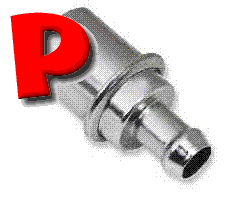|

Pa
Parking
Brake The parking brake holds one or more brakes continuously in
the applied position. The parking brake employs the regular drum
brakes on the rear wheel. Instead of hydraulic pressure, however, a
simple mechanical linkage is used to engage the brake
shoes.
When the parking-brake pedal is depressed (or, in some cars, a hand
lever is raised), a steel cable pulls taut a tension lever; other
cables draw the brake
shoes
firmly against the drums. The release knob slackens the cables and
disengages the brake
shoes.
The parking brake is self adjusting. An automatic adjuster in the
piston moves on the thrust screw to compensate for lining wear.
PCM
Power Control Module
PCV
valve See positive
crankcase vent valve.
PFI
Port Fuel Injection
Pinging
The sound an engine makes when it is suffering from detonation or
preignition. This is often a warning that the gasoline being burned
has insufficient octane, and it can be a very hazardous condition for
an engine.
Pinion
A small diameter gear with a small number of teeth designed to
mesh with a much larger gear wheel or a toothed rod (rack). Used in
rack-and-pinion steering and for speed reduction with an increase in power.
Piston,
Rings, and Wrist Pin The piston converts the potential energy of
the fuel into the kinetic energy that turns the crankshaft. The
piston is a cylindrical shaped hollow part that moves up and down
inside the engine's cylinder. It has grooves around its perimeter
near the top where rings are placed. The piston fits snugly in the
cylinder. The piston rings are used to ensure a snug "air
tight" fit. The wrist pin connects the piston to the connecting
rod. Pistons are made of aluminum, because it is light and a good
heat conductor. The piston head or "crown" is the top
surface against which the explosive force is exerted. It may be flat,
concave, convex or any one of a great variety of shapes to promote
turbulence or help control combustion. In some, a narrow groove is
cut into the piston above the top ring to serve as a "heat
dam" to reduce the amount of heat reaching the top ring.
Piston Rod A
shock absorber rod which operates the piston in a telescopic damper
Plastigage
A thin strip of plastic thread, available in different sizes, used
for measuring clearances.
For
example, a strip of Plastigage is laid across a bearing journal. The
parts are assembled and dismantled; the width of the crushed strip
indicates the clearance between journal and bearing.
Ply
Rating A measure of the strength of tires based upon the
strength of a single ply of designated construction. An eight-ply
rating does not necessarily mean the tire has eight plies, but rather
that the tires has the strength of eight standard plies.
Positraction
General Motors' trade name for a limited-slip
differential.
Pneumatic Tire
A circular tube of rubber or synthetic rubber and fabric, and
sometimes also steel, attached to the rim of the car's wheel, having
resilience due to its containing air under pressure.
Poppet
Valve A
valve structure consisting of a circular head with an elongated stem
attached in the center, very much like the shape of a mushroom with a
flat top. It is designed to open and close a circular hole or port.
Its name comes from the fact that it pops up and down. In engines, it
is the valve used to open and close the valve port entrances to the
engine cylinders.
|
Porsche
A vehicle brand of which the Series 356 for 1949-64 are milestone
cars. The 356C for 1965 is a milestone car. |
 |
The official
"date of birth" for the first Porsche is considered being
June 8, 1948. Number one, a two-seat 356 with a 1.1 litre centre
engine, 40 HP weighing 650 kg. The following 50 speciemens of the
so-called 356/2 were hand built in Gmünd/Kärnten (Austria).
These cars almost resembled the classic 356 and are today, if at all
to be found, almost priceless.
Port
Fuel Injection (PFI) A type of fuel injection with at least one
injector mounted in the intake port(s) of each cylinder. Usually the
injector is mounted on the air intake manifold close to the port.
Port fuel injection improves fuel distribution and allows greater
flexibility in intake-manifold design, which can contribute to
improved engine breathing. Also called multi-point injection
Positive
Crankcase Vent Valve Abbreviated PCV valve. An
emissions-reduction device that has been used on most cars from the
late '60s to the present. Blowby and other factors can allow
combustion gases, as well as some unburned air and fuel, into an
engine's crankcase. The PCV valve uses engine vacuum to remove these
gases and reroute them back into the intake system, so they can be
burned, rather than dumped into the atmosphere.
Power
Brakes Power brake are of four general types: vacuum suspended;
air suspended; hydraulic booster, and electro-hydraulic booster. Most
power brakes use vacuum suspended units, which contain a large
vacuum-powered booster device to provide the added thrust to the
typical power-brake. Pressure on the brake pedal pushes forward a rod
connected to the pistons of the two master cylinders. The pistons
begin forcing fluid into the front and rear brake lines. At the same
time, the brake-pedal pushrod positions the vacuum-control valve so
that it closes the vacuum port and seals off the forward half of the
booster unit. The engine vacuum line then draws off the air, creating
a low-pressure vacuum chamber. Atmospheric pressure in the control
chamber then pushes against the diaphragm, dividing the two chambers.
The pressure on the diaphragm, which is locked to the pushrod, forces
it forward, supplying even more pressure on the pistons. The safe
driver is always ready to apply the total force needed to stop their
vehicle, even if the engine quits (removing the power assist).
Predetonation
The undesirable "knock" or "ping" that occurs
when the ignition of the air-fuel mixture occurs before the ignition
spark. Also known as "pre-ignition".
Primary
Circuit
The low voltage (6 or 12 volts) path of the ignition
system which goes from the positive pole of the battery
to the primary windings
of the coil,
through the breaker points, and into the ground which leads back to
the negative pole of the battery.
Primary
Winding
Primary
Windings The low voltage (6 or 12 volt) windings
in ignition coil,
the primary winding is heavy wire; secondary winding uses fine wire.
Primary
Wire
Primary
Wires
The
wiring which serves the low voltage part of the ignition
system. Wiring from battery to switch, resistor, ignition
coil, distributor points.
Propeller
Shaft The long hollow tube with universal joints at both
ends that carries power from the transmission to the differential on
front-engined rear wheel drive vehicles.
Proportioning
Valve A hydraulic control valve which limits the amount of
pressure to the rear brakes during panic stops to prevent wheel lock-up.
Pushrod
Push
Rod A push rod is a connecting link in an operating mechanism.
Two examples are the rod between the valve lifter and rocker arm on
an overhead valve engine, and push rods at the piston ends which
apply pressure to the brake
shoes.

A
B
C
D
E
F
G
H
I J
K
L
M
N
O
P
Q
R
S
T
U
V W
X
Y
Z |